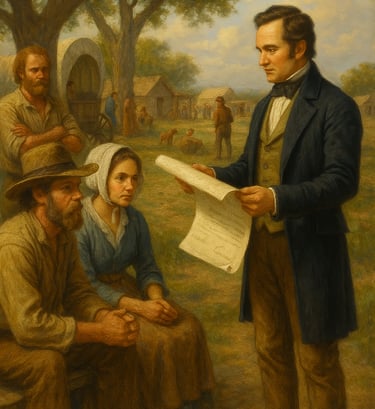Mexico’s Northern Gamble (1821–1834)
Discover how Mexico’s risky settlement strategy in Texas (1821–1834) backfired—leading to unrest, U.S. immigration, and the road to revolution.


A New Nation and a Bold Bet
In 1821, Mexico won its independence from Spain. Suddenly, a vast, sparsely populated territory called “Tejas” was theirs to manage. Stretching far beyond modern-day boundaries, it was beautiful—rich in rivers, prairies, forests, and wildlife—but it was also vulnerable. Native tribes like the Comanche and Apache still fiercely defended their territory, and the nearest Mexican settlements were hundreds of miles away.
So, Mexico made a gamble: what if outsiders—specifically, Anglo-Americans—could be used to colonize Texas and act as a human buffer against native raids and American encroachment?
Enter the Empresario
Mexico offered land grants to empresarios—contractors who promised to bring in settlers to farm the land and swear allegiance to Mexico. The most famous was Stephen F. Austin, who brought the first “Old Three Hundred” families from the United States into the lower Brazos River area.
They were required to:
Become Mexican citizens
Practice Catholicism (at least on paper)
Learn Spanish
Swear loyalty to Mexico
But in practice? Many settlers held tightly to their American culture, language, and Protestant faith. Some even brought enslaved African Americans with them, despite Mexico’s growing opposition to slavery.
Coahuila y Tejas
Mexico joined Texas with the state of Coahuila to form “Coahuila y Tejas.” It was a political arrangement that gave Texas little local power. Texans often felt like second-class citizens in a system that rarely considered their unique frontier challenges.
A Fragile Peace
For a while, it worked. Anglo settlers began farming cotton, building cabins, trading with native groups, and forming tight-knit communities in places like San Felipe de Austin and Nacogdoches.
But trouble loomed.
The Mexican government began to worry about losing control. By the late 1820s:
U.S. immigration into Texas was exploding
Settlers weren’t assimilating as expected
Mexico had outlawed slavery, creating friction
U.S. politicians were openly talking about annexing Texas
In 1830, Mexico issued the Law of April 6, banning further immigration from the U.S. and restricting land contracts. Many Anglo settlers saw this as a betrayal and began to resist.
The Spark Before the Storm
Tensions grew. Mexican military presence increased. Texian distrust of the Mexican government deepened. The seeds of rebellion were being sown.
Though Texas had not yet begun its fight for independence, Mexico’s gamble was starting to backfire. The Anglo settlers they had invited in were growing restless, and the fragile trust between the two sides was breaking.
The stage was set for revolution.


